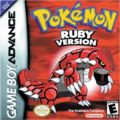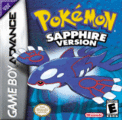Pokémon: Ruby and Sapphire Versions
 
| |
| Pokémon: Ruby and Sapphire Versions | |
| Developer | Game Freak |
| Publisher | Nintendo |
| System | Game Boy Advance |
| Release Date | JP November 21, 2002 US March 17, 2003 AU April 3, 2003 EU July 25, 2003 |
| Rating | ESRB: E |
Pokémon: Ruby Version and Pokémon: Sapphire Version are the third set of games in the Pokémon series. The different versions were made to increase interactivity between gamers (as gamers would have to trade Pokémon with each other in order to collect all of the game's monsters).
Story
Pokémon: Ruby and Pokémon: Sapphire follows the adventures of a young Pokémon trainer. In this game, the player has the option of playing a boy or a girl, with the other character becoming your rival.
This game features journeys across a new area know as Hoenn. The player battles trainers and earns badges to earn a shot at the Pokémon League championship. At the same time, the player must thwart the efforts of a local radical organization that seeks to change the land to reflect their own ideals. In Ruby, the enemies are Team Magma, who seek to wake Groudon in order to expand the land for them. In Sapphire, the enemies are Team Aqua, who seek to wake Kyogre in order to expand the oceans.
Gameplay
Pokémon Ruby and Sapphire retains much of the gameplay of the original set of games. However, they have added some things. The most notable addition is over 100 new species of Pokémon the game introduced.
One of the new features added in Ruby and 'Sapphire is the Pokémon Contests. The Contests are similar to pet shows in real life in which the player must try to impress the judges with their Pokémon. This also brings in a system of planting berry trees. Some of the new features from Crystal, such as choosing a gender, remain, although the day/night system was disavowed. The game still was able to tell separate days, however.
In addition, double battles were added. In double battles, two Pokémon fight as a team.
Connectivity
Ruby and Sapphire can connect with each other and trade as well as trade with Emerald and FireRed and LeafGreen using a Link Cable. However, none of these games are able to trade with older games due to changes in the game's code. Thus, linking to FireRed and LeafGreen is one of the only ways of getting many of the original 250 Pokémon in Ruby and Sapphire.
Through the Gamecube/Gameboy Advance Link, players can store their Pokémon in Pokémon Box. Certain bonuses can be transfered from Pokémon Colosseum to Ruby and Sapphire, including Jirachi. The games also make use of the e-Reader. There are certain islands with rare Pokémon that can only be reached by using an e-Reader and a special promotional card.
The pair of games can also connect to Pokémon Diamond and Pearl using the dongle method. This can only be done once the player sees all 150 Pokémon in Diamond and Pearl. The Pokémon from 'Ruby and Sapphire are transferred and can't be traded back.
Version Differences
In all regions, Pokémon Ruby and Sapphire released simultaneously. In order to increase player interactivity, each version had certain Pokémon the other didn't. There were also storyline differences between the two games; in Ruby Team Magma served as the main adversaries while Team Aqua was the main enemy of Sapphire. The games also had version-exclusive legendary Pokémon, a first in the series.
In addition, there were certain Pokémon that could only be found in Pokémon FireRed and Pokémon LeafGreen.
Legacy
Sequels
These games were followed up by the fourth generation games, Pokémon: Diamond and Pearl Versions.
Remakes/Rereleases
- In 2001 a third version, Pokémon: Emerald Version was released. The game followed the stories of both Team Aqua and Team Magma rather than just one. Also, the Battle Frontier area was added to the game.
- In 2014, these games received sixth generation remakes for the Nintendo 3DS that were known as Pokémon: Omega Red and Alpha Sapphire Versions. These versions expanded the storyline and gave a graphics overhaul as well as implementing various features from the sixth generation games.